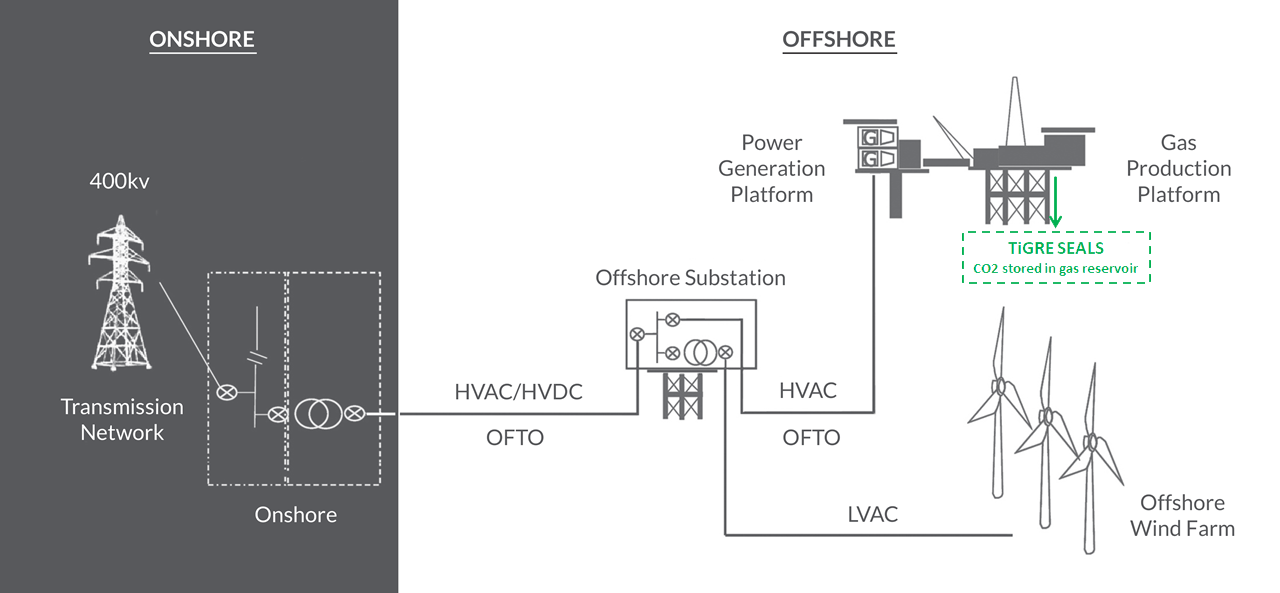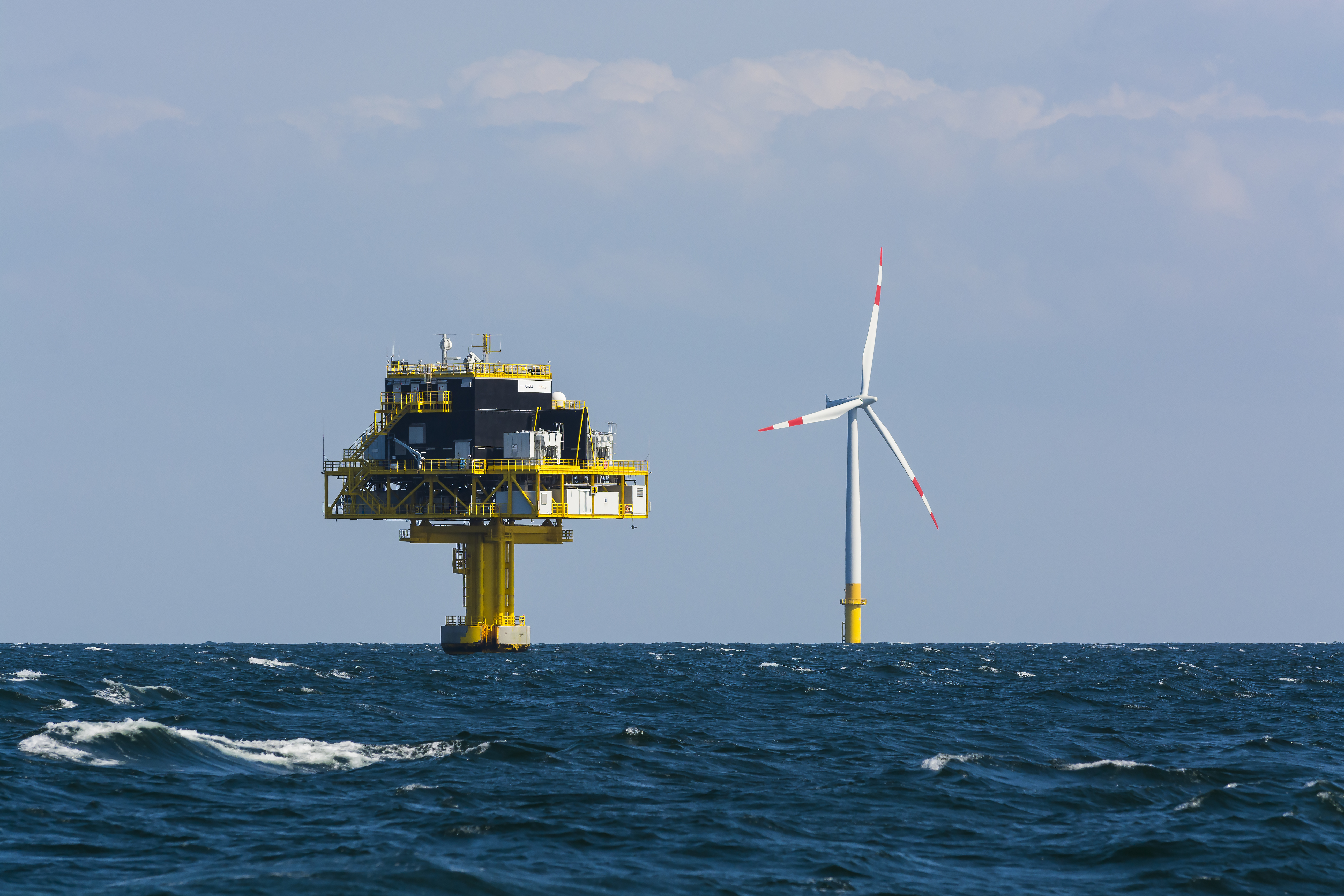About SEALS
TiGRE SEALS is a concept for producing flexible power generation using indigenous natural gas resources without producing CO2. It offers significant potential as a transitional technology to Net Zero. It does this through the in situ vertical integration of the gas production, power production, CO2 capture and sequestration activities within a closed circuit.
TiGRE SEALS is a product of a feasibility study, joint funded by the UK government (BEIS) and TiGRE. This study has shown that a TiGRE SEALS gas to wires project could potentially provide lowest levilised cost of energy (LCOE) option to capture and sequester carbon while maintaining flexible and dispatchable power generation, relative to any other gas power generation and carbon capture utilisation and storage (CCUS) option currently under consideration within the UK.
The feasibility study looked at CCUS from a different perspective to conventional methods: how to generate power to simplify the extraction of CO2 from its exhaust gases? This innovative approach and design rely on Oxyfuel Direct Combustion with H2O as a supplemental working fluid and CO2 capture into dense phase for direct storage underground. in January 2021, TiGRE submitted two patent applications relating to the SEALS system and its key components.
Oxyfuel Power plants have a lower LCOE than a standard TiGRE™ gas to wires power plant at load factors above 40%. This indicates that a TiGRE SEALS project would not require CO2 subsidies to be competitive in the merchant power market for peaking plant.


Policy context
TiGRE SEALS provides an excellent fit for current UK policy. There is a resurgence of interest in CCUS in the UK as a key part its decarbonisation agenda. CCUS is now part of a live policy and implementation debate in a way it has not been for several years.
The scale of the opportunity for CCUS in the UK is expected to be significant under any ‘Net Zero’ scenario, and ongoing policy discussions are planning to make CCUS a reality. There are a number of specific live policy discussions that are relevant for SEALS:
- The BEIS CCUS consultation responses on business models and the re-use of oil and gas offshore assets (August 2020) proposed a Dispatchable Power Agreement business model based on the CfD framework model for available power CCUS capacity, the encouragement of owners to enter a period of suspension prior to decommissioning to make assets available for CCUS, and discretionary powers for the Secretary of State to waive the decommissioning liability of an oil and gas infrastructure owner if those assets are to be re-used for CCUS deployment;
- The UK Emissions Trading Scheme, made statutory in November 2020 and due to start in 2021, as the UK Government aims to “lead the world on carbon pricing”;
- BEIS, the OGA, Crown Estate, Ofgem and other industry stakeholders completed the UK Continental Shelf Energy Integration Project in 2020. It recommended that the oil and gas industry engage and collaborate on CAPEX-efficient opportunities such as oil and gas platform electrification with gas-to-wire capacity. Notably, TiGRE SEALS was one of the four examples cited in the Integration Study final report;
- In December 2020, the Government published its Ten Point Plan for a green industrial revolution and the Energy White Paper, highlighting investment in CCUS as a priority point, setting the ambition to capture 10Mt of carbon dioxide a year by 2030 and to support at least one power CCUS plant to be operational by 2030, as well as to put in place a commercial framework that will enable developers to finance the construction and operation of a power CCUS plant and stimulate a pipeline of projects.
Source: Ministerial foreward; Industrial Decarbonisation Strategy (HM Government, March 2021)
Context
The size of the market for carbon-neutral flexible and dispatchable power is extensive, not only in the UK but overseas too.
There is significant potential for offshore carbon-neutral gas to wire projects in the UK, particularly in the southern North Sea and the east Irish sea. Schlumberger – a technology partner on the SEALS feasibility study project who undertook the subsurface work scope – has undertaken a further study entitled North Sea reservoir screening for CO2 injection. This report shows that there are significant numbers of UKCS gasfields with both sufficient remaining gas reserves and the required characteristics for CO2 injection. The report identified clear potential for more than twenty 200MW TiGRE SEALS. The technology could equally apply to any province which has a combination of electricity demand and depleted gas reserves, including the Dutch sector of SNS, Norway, Germany, and further afield, the Gulf of Mexico, Venezuela, Russia and Canada.
Each 200MW TiGRE SEALS project could generate 14 terawatt-hours (TWh) of on-demand electricity while capturing and sequestering 5 million tonnes of CO2 over its lifetime of 15-20 years.
SEALS is a transitional technology that will support the move to renewables and hydrogen over the coming 20-30years.
- Gas to wire with CO2 capture (offshore and onshore). The problem that TiGRE SEALS overcomes is the efficient and cost-effective method of converting hydrocarbons to electricity whilst capturing and storing the CO2.
- Electricity generation from hydrogen. SEALS can be used as an efficient method of converting hydrogen to electricity which means the technology is future proof in a post-hydrocarbon world.

TiGRE SEALS offers a highly competitive CCUS solution
- TiGRE SEALS is indirectly competing with CCGT’s retrofitted with CO2 capture (mostly through chemical absorption CO2 separation systems). These systems are highly inefficient, energy intensive, spatially demanding, difficult to scale, and not able to meet flexible dispatchable electricity generation profile.
TiGRE SEALS can create cross-sector benefits through providing a transitional energy solution fit for a carbon-neutral future:
- To the oil and gas sector through providing a life extension opportunity for end-of-life gasfields.
- To the renewable sector through providing physical balancing power and contributing 25% towards transmission costs for offshore windfarms thereby improving its commercial viability for subsidy-free power.
- Wider social benefits through the creation of employment extension opportunities.
- To the UK economy through providing a pathway for lowest cost of energy with CCUS while maintaining flexible dispatchable power; through delaying the financial burden of decommissioning the gasfields in the SNS and by helping meet national and international CO2 reduction targets.
